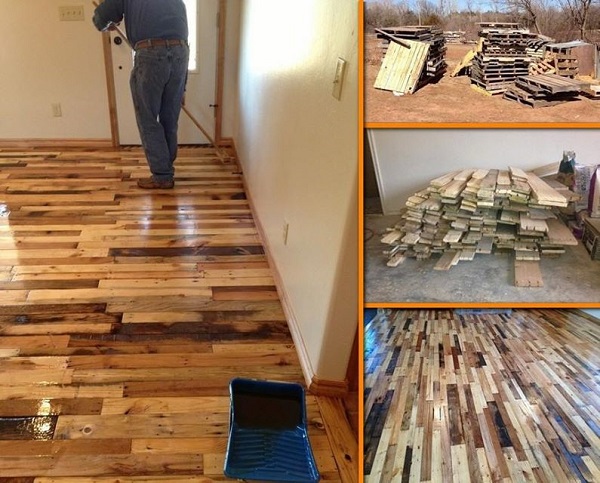Have you ever looked at a stack of weathered pallets and imagined them transformed into something beautiful? The idea of using pallet wood for flooring might seem unconventional, but it’s becoming increasingly popular as people seek unique, sustainable, and budget-friendly ways to personalize their homes. But can pallet wood really be used for flooring? And if so, what are the pros and cons?

Image: dragon-upd.com
This guide delves into the world of pallet wood flooring, exploring its potential, challenges, and the steps involved in bringing this rustic charm to your home. From understanding the different types of pallets to mastering the preparation and installation process, we’ll explore everything you need to know to embark on this DIY adventure.
The Allure of Pallet Wood Flooring
Pallet wood flooring offers a unique blend of affordability, sustainability, and rustic charm that appeals to a growing number of homeowners. It’s a tangible expression of the “upcycling” movement, allowing you to repurpose discarded materials into something beautiful and functional. The knots, imperfections, and natural variations in the wood add a raw, handcrafted aesthetic that stands out from traditional flooring options.
Is It Right for You? The Pros and Cons of Pallet Wood Flooring
Before you dive into the exciting world of pallet wood flooring, it’s crucial to weigh the pros and cons to determine if it aligns with your needs and preferences.
Pros:
- Affordability: One of the biggest advantages of pallet wood flooring is its cost-effectiveness. Compared to traditional hardwoods, pallets offer a significant price advantage, especially when sourcing them directly from businesses.
- Sustainability: Repurposing pallets reduces waste and promotes a more eco-conscious approach to home décor. You’re giving discarded materials a new life, lessening the environmental impact of the construction industry.
- Uniqueness: Pallet wood flooring boasts a distinctive aesthetic that sets it apart from conventional flooring options. The natural imperfections and variations in the wood create a truly one-of-a-kind look.
- DIY Potential: Pallet wood flooring projects are widely considered approachable for do-it-yourselfers. With some basic woodworking skills and a little patience, you can create stunning floors in your home.
Cons:
- Durability: While pallet wood can be sturdy, it might not endure the same level of heavy foot traffic or moisture as traditional hardwood flooring.
- Hidden Chemicals: Some pallets are treated with pesticides or fire retardants, so it’s essential to source pallets specifically designed for reuse or consult with recycling centers for safe and environmentally friendly options.
- Preparation: Transforming pallets into flooring requires significant preparation. This includes dismantling the pallets, removing staples, sanding, and sealing the wood to ensure a smooth, durable surface.
- Appearance: While the rustic aesthetic is appealing to many, it might not suit every design style.
Sourcing Your Pallet Wood
Whether you plan to use recycled pallets or find a supplier that specifically makes flooring from pallet wood, it’s important to consider the following factors:
- Origin: Understand where the pallets came from to ensure they’re safe and appropriate for flooring.
- Condition: Inspect the pallets for signs of damage, rot, or infestation.
- Wood Type: Identify the wood species, as this will impact the look and durability of your flooring.
- Treatment: Determine if the pallets are chemically treated, and if so, source safer alternatives.

Image: goodshomedesign.com
The Transformation Process: Creating Flooring from Pallet Wood
Transforming reclaimed pallets into flooring involves a series of crucial steps:
- Disassembly: Carefully disassemble the pallets, removing nails and staples.
- Cleaning: Thoroughly clean the wood, removing dust, debris, and remnants of any previous use.
- Sanitation: If the pallets are suspected of being treated with chemicals, consult with a professional about appropriate sanitation methods.
- Sanding: Sand the wood to create a smooth surface and remove any irregularities.
- Finishing: Apply coatings, stains, or sealants to enhance the appearance and protect the wood.
Installation Techniques: A Guide to Laying Your Pallet Wood Floor
Once your pallet wood is prepped, you’re ready for installation.
- Subfloor: Ensure a stable subfloor, as pallet wood is not as forgiving as traditional hardwood floors.
- Adhesive: Use a high-quality construction adhesive to bond the pallet wood planks to the subfloor.
- Spacing: Leave room for expansion and contraction, as wood naturally reacts to temperature changes.
- Finishing Touches: Consider using molding or trim to complete the installation and enhance the aesthetic appeal.
Design Tips for a Stunning Pallet Wood Floor
Your pallet wood flooring project is a chance to create a truly unique and personal space. Here are some design tips to help guide your creative journey:
- Mix & Match: Play with different wood tones and textures to create visual interest.
- Rustic Embrace: Embrace the natural imperfections of the wood for a truly authentic look.
- Color Palette: Consider the color scheme of your room and choose stains or finishes that complement your design.
Can Pallet Wood Be Used For Flooring
Conclusion: Embracing the Charm of Pallet Wood Flooring
Creating a pallet wood floor is a rewarding DIY project that brings unique beauty, sustainability, and personal expression to your home. By carefully sourcing your pallets, addressing the necessary preparation steps, and following proper installation techniques, you can craft a beautiful and durable floor that reflects your individuality and commitment to eco-conscious design.
Don’t be afraid to embrace the rustic charm and the endless possibilities of this repurposed material. Start your journey today, and let your home tell a story of sustainability and creativity!






